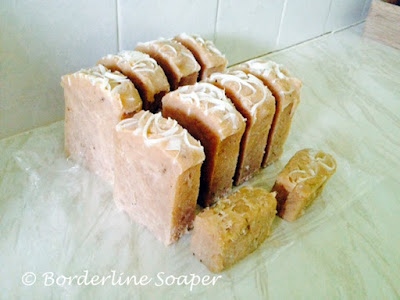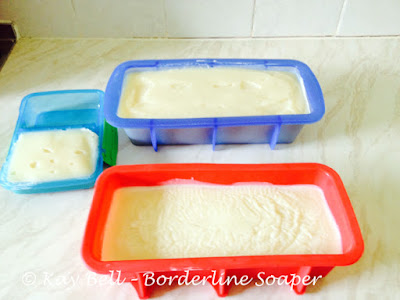I couldn't wait for my soap to cure before making another batch, it's a learning curve trying out differing recipes and oils.
Soap 3... made 15/08/2015
My next recipe used almond oil, cocoa butter, coconut, olive oil, and rain water, it was a simple recipe without any additions of fragrance or colour....
I was pleased to have a little case of essential oils on hand, only small bottles, I don't like strong heavy scents so chose a mixture of geranium, bergamot and roman chamomile, using only 6gms. I was happy that I had added the essential oils to the second loaf and that this one had gelled successfully.
The soap slices were huge so I cut them again, I think that these smaller pieces will be easier to use.
Soap 3... made 15/08/2015
My next recipe used almond oil, cocoa butter, coconut, olive oil, and rain water, it was a simple recipe without any additions of fragrance or colour....
I carried on and made a second batch using my quilting and soaping friend Charlie's hard bar recipe using castor oil, cocoa butter, coconut oil, olive oil and palm oil, this time I added some essential oils and soon had them tucked up in their moulds under towels to keep them snug
I had a feeling that my first loaf wasn't going to 'gel' but carried on and placed the second loaf in beside it, soon the second loaf was hot but the first was cooling down. I left them both there for a couple of hours to see what would happen. The first loaf didn't show any signs of warming up, in hind sight I should have stepped in sooner, it was late at night but before going to bed I thought I would pop that loaf in the bottom of my Aga for half an hour, that did indeed start the gel process. After half an hour I put the loaf back under the towels and went to bed leaving the soap loaves to do there own thing.
Next day the first loaf looked a bit dry and mottled but I was really pleased with the second loaf and little loaflettes
Soap 4...I cut both loaves and although I am sure the first loaf would have still been soap I decided to have a play and rebach it and add a bit of colour in the form of cold tea straight from the teapot. I also added a little coconut milk and a little olive oil to help the soap soften, along with some real ground black peppercorns and blackpepper and neroli essential oils. I know I should have taken a photo of it in the pan in the bottom of my Aga but I'm sure there will be another opportunity.
The soap slices were huge so I cut them again, I think that these smaller pieces will be easier to use.
 |
| Blackpepper Tea loaf |
Of course this is a softer soap, I'm thinking it will take two or three months to cure and dry out.
 |
| Smooth Geranium bars |
I love the fragrance of this geranium soap and can't wait to try it out, may have to be a few weeks yet though...

































